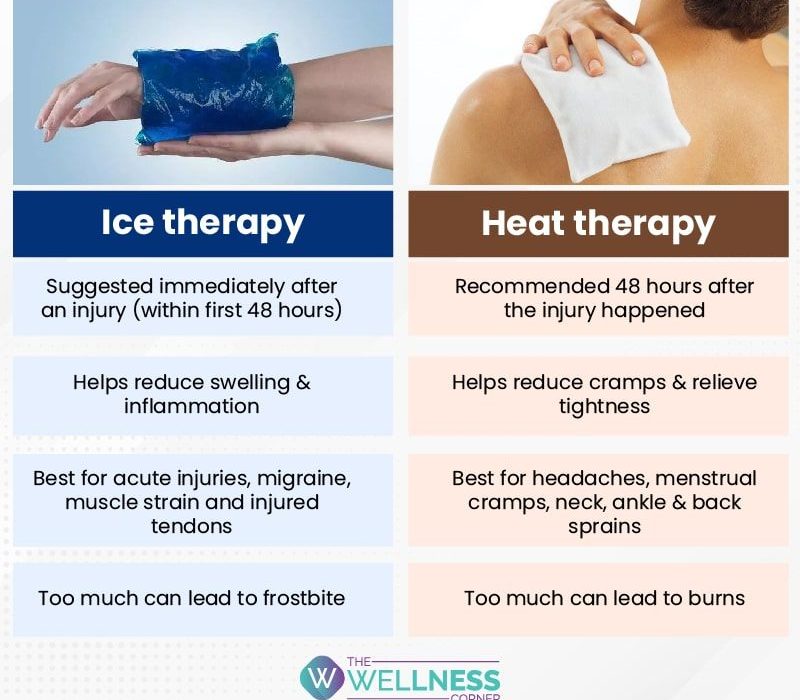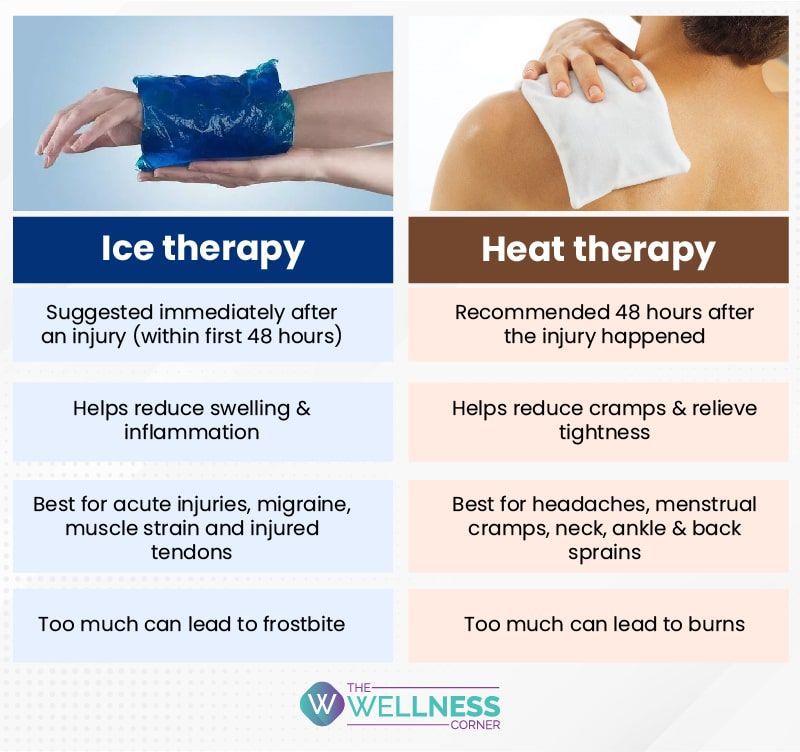Feeling aches and pains can really put a damper on our day. Whether it’s a sore muscle from an intense workout or a nagging pain from an injury, finding relief is always a top priority. That’s where heat therapy comes in. But how does heat therapy help with pain relief? Let’s dive into the science behind this soothing technique and discover how it can provide some much-needed comfort.
When it comes to pain, heat can work wonders. Applying heat to a painful area helps to increase blood flow, promoting healing and relaxation. It’s like a warm embrace for your muscles, easing tension and reducing inflammation. Heat therapy can be used for a variety of conditions, from muscle strains and arthritis to menstrual cramps and chronic pain. So, whether you’re recovering from a tough workout or dealing with ongoing discomfort, heat therapy can offer some much-needed relief. But how exactly does it work its magic? Let’s take a closer look.
How Does Heat Therapy Help with Pain Relief?
Heat therapy is a popular and effective method for relieving pain and promoting healing in the body. Whether it’s a heating pad, hot water bottle, warm towel, or a soak in a warm bath, heat therapy has been used for centuries to alleviate discomfort. But how exactly does it work? In this article, we will explore the benefits of heat therapy and how it can help bring relief to various types of pain.
The Science Behind Heat Therapy
Heat therapy works by increasing blood flow to the affected area, which helps to relax muscles and reduce stiffness. When heat is applied to the skin, it causes blood vessels to dilate, allowing more oxygen and nutrients to reach the tissues. This increased blood flow helps to remove waste products and toxins, which can contribute to pain and inflammation.
Additionally, heat therapy stimulates sensory receptors in the skin, which can help to block pain signals from reaching the brain. This is why many people find heat therapy particularly effective for relieving muscle aches, joint pain, and menstrual cramps. The soothing warmth also promotes relaxation and can help to reduce stress and tension, further enhancing its pain-relieving effects.
Benefits of Heat Therapy
1. Muscle Relaxation: Heat therapy is known for its ability to relax tense muscles and relieve muscle spasms. This can be especially beneficial for individuals with chronic muscle pain or conditions such as fibromyalgia.
2. Pain Relief: Heat therapy can provide temporary relief from pain by reducing inflammation and increasing blood flow. It is commonly used to alleviate back pain, arthritis pain, and sports injuries.
3. Improved Flexibility: Applying heat to stiff joints and muscles can help to increase flexibility and range of motion. This can be particularly helpful for individuals with conditions like osteoarthritis or rheumatoid arthritis.
4. Faster Healing: Heat therapy promotes healing by increasing circulation and delivering essential nutrients to injured tissues. It can be beneficial for reducing recovery time after an injury or surgery.
5. Stress Reduction: The relaxation induced by heat therapy can help to reduce stress and tension in the body. This can have a positive impact on overall well-being and may contribute to better sleep quality.
Tips for Using Heat Therapy
1. Choose the Right Temperature: It’s important to use a temperature that is comfortable for you. Avoid extreme heat that can cause burns or discomfort.
2. Use a Barrier: To protect your skin, always use a barrier such as a towel or cloth between the heat source and your skin. This helps to prevent burns and allows for more even distribution of heat.
3. Limit Application Time: Heat therapy should typically be applied for no more than 20 minutes at a time. Prolonged exposure to heat can lead to skin irritation or other complications.
4. Avoid Heat on Inflamed or Swollen Areas: If you have an acute injury or an area that is swollen or inflamed, it is best to avoid heat therapy. Cold therapy may be more suitable in these cases.
5. Consult with a Healthcare Professional: If you have any underlying health conditions or concerns, it’s always a good idea to consult with a healthcare professional before starting heat therapy.
In conclusion, heat therapy is a natural and effective method for relieving pain and promoting healing in the body. By increasing blood flow, relaxing muscles, and reducing inflammation, heat therapy can provide much-needed relief from a variety of painful conditions. Just remember to use caution, choose the right temperature, and limit application time to ensure a safe and beneficial experience.
Key Takeaways: How does heat therapy help with pain relief?
- Heat therapy can help relieve pain by increasing blood flow to the affected area.
- Applying heat can relax muscles and reduce muscle spasms, providing relief from pain.
- Heat therapy can also help reduce inflammation and swelling, which can alleviate pain.
- Heat can stimulate the sensory receptors in the skin, distracting the brain from feeling pain.
- Using heat therapy, such as hot packs or warm baths, can promote relaxation and overall well-being.
Frequently Asked Questions
How does heat therapy work for pain relief?
Heat therapy, also known as thermotherapy, is a natural and effective way to alleviate pain. When applied to the affected area, heat increases blood flow, relaxes muscles, and reduces stiffness. This increased blood flow helps deliver oxygen and nutrients to the damaged tissues, promoting healing. Heat therapy also stimulates sensory receptors in the skin, which helps to block the transmission of pain signals to the brain.
In addition to improving blood circulation, heat therapy can also help to reduce muscle spasms and increase joint flexibility. The warmth from the heat source helps to relax tense muscles and relieve tension, which can be particularly beneficial for individuals suffering from conditions such as arthritis or muscle strains. Overall, heat therapy provides a soothing and comforting sensation that can help alleviate pain and promote relaxation.
What types of heat therapy can be used for pain relief?
There are various types of heat therapy that can be used to relieve pain. Some common methods include hot water bottles, heating pads, warm towels, and warm baths. These methods can be easily applied to the affected area, providing targeted heat therapy. Another popular form of heat therapy is the use of heat wraps or patches, which can be applied directly to the skin and provide continuous heat for several hours.
It is important to note that heat therapy should be used with caution and not be applied directly to open wounds or areas of the body with reduced sensation. It is always recommended to consult with a healthcare professional to determine the most suitable and safe form of heat therapy for your specific condition.
Can heat therapy be used for chronic pain?
Yes, heat therapy can be beneficial for individuals experiencing chronic pain. Chronic pain conditions such as arthritis, fibromyalgia, and lower back pain can often benefit from the use of heat therapy. The heat helps to relax muscles, reduce inflammation, and improve blood flow to the affected area, providing relief from ongoing discomfort.
It is important to note that while heat therapy can provide temporary relief, it is not a cure for chronic pain. It is essential to work with a healthcare professional to develop a comprehensive pain management plan that includes various treatment modalities, such as medication, physical therapy, and lifestyle modifications.
When should heat therapy be avoided?
While heat therapy can be beneficial for many individuals, there are certain situations where it should be avoided. Heat therapy should not be used on areas of the body with impaired sensation or reduced blood flow. It is also not recommended to apply heat therapy to open wounds, infections, or areas of acute inflammation.
Additionally, individuals with certain medical conditions such as diabetes, deep vein thrombosis, or multiple sclerosis should consult with a healthcare professional before using heat therapy. It is important to follow the guidance of a healthcare professional to ensure that heat therapy is safe and appropriate for your specific condition.
Are there any risks or side effects associated with heat therapy?
When used correctly, heat therapy is generally safe and well-tolerated. However, there are some risks and potential side effects associated with its use. Applying excessive heat or leaving heat therapy on for too long can cause burns or skin irritation. It is important to use a barrier, such as a towel or cloth, between the heat source and the skin to prevent direct contact and minimize the risk of burns.
It is also important to monitor the temperature and duration of heat therapy to avoid overheating the body or causing discomfort. If you experience any adverse reactions such as increased pain, swelling, or skin changes, it is recommended to discontinue heat therapy and consult with a healthcare professional.
Overall, when used appropriately and under the guidance of a healthcare professional, heat therapy can provide effective pain relief with minimal risks or side effects.
Ice Or Heat For Back Pain Relief & Injury?
Final Summary: Unlocking the Soothing Power of Heat Therapy
As we wrap up our exploration of heat therapy and its role in pain relief, it’s clear that this simple yet effective technique holds great potential for easing discomfort. Whether you’re dealing with muscle aches, joint stiffness, or menstrual cramps, heat therapy can be a valuable tool in your pain management arsenal. By applying heat to the affected area, you can increase blood flow, relax tense muscles, and promote healing.
The beauty of heat therapy lies in its accessibility and versatility. From hot water bottles and heating pads to warm baths and warm compresses, there are numerous ways to harness the soothing power of heat. It’s important to remember that heat therapy is not a one-size-fits-all solution, and it’s always wise to consult with a healthcare professional to determine the best approach for your specific needs.
Incorporating heat therapy into your pain relief routine can provide that much-needed comfort and relief, allowing you to get back to doing the things you love. So, the next time you find yourself in need of a little TLC for your aching body, consider turning up the heat and embracing the therapeutic benefits that heat therapy has to offer. Your body will thank you!




